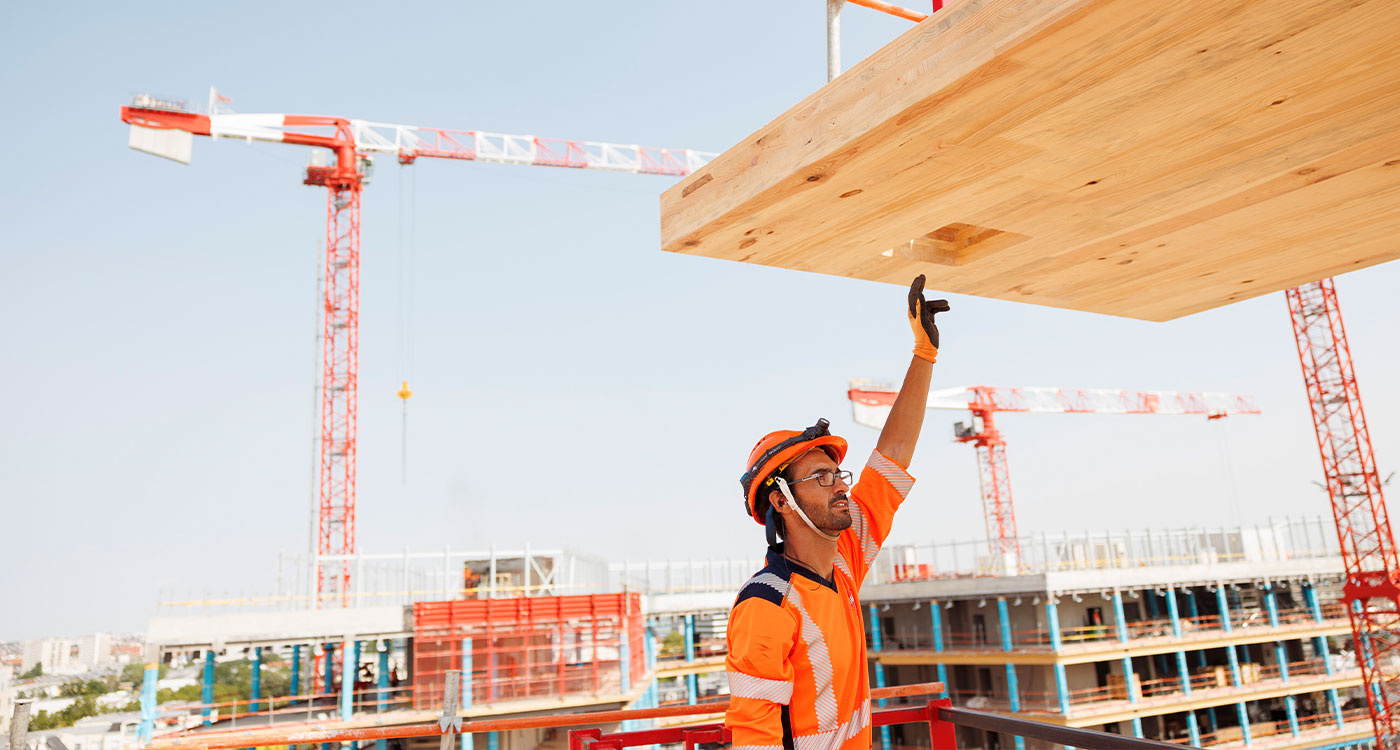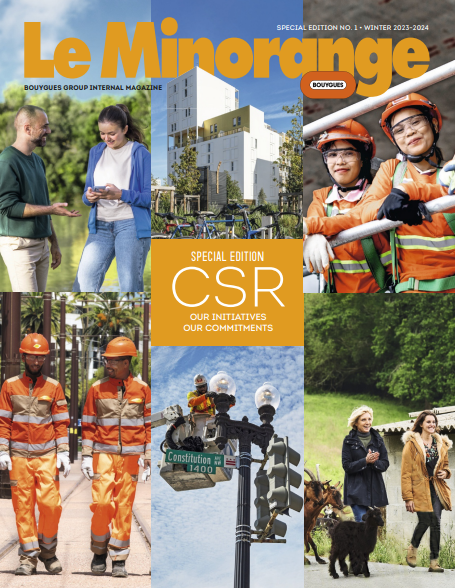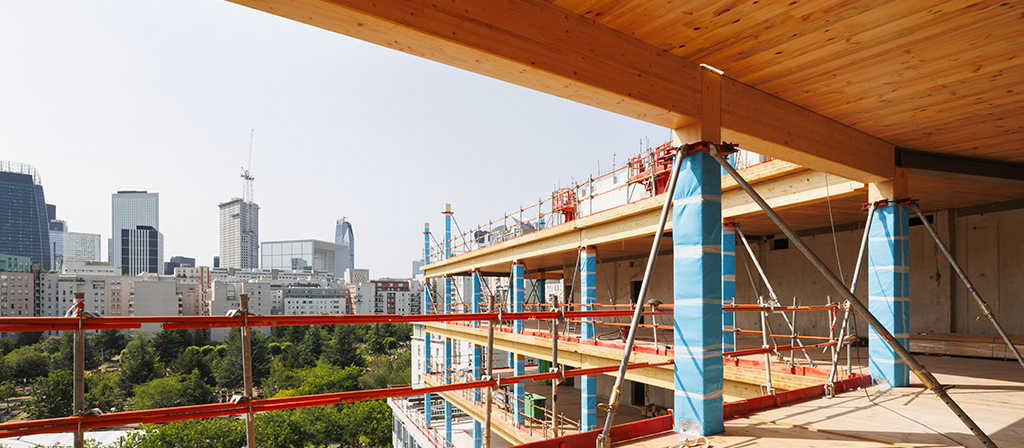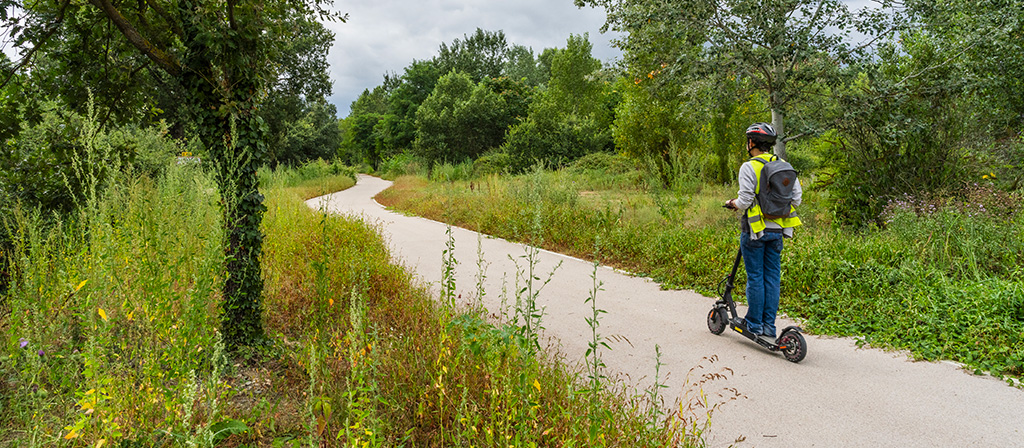
Bulding better with bio-sourcing
Construction activities account for 93 percent of the Group’s greenhouse gas emissions. One way to reduce this carbon footprint is to opt for bio-based building materials, that is, ones made from substances derived from living organisms.
Here we look at Bouygues Construction’s growing use of wood construction for the future Engie group head office in La Garenne-Colombes and the Vegecol asphalt mix developed by Colas.
by Emilie Dupas

DISCOVER OUR MINORANGE SPECIAL EDITION
SPECIAL CSR
93 %
of the Group’s greenhouse gas emissions.
the wood revolution
Cranes swing back and forth continually at the former site of a Peugeot automotive plant. The four office buildings comprising the Engie Campus will have either six or seven floors, a total floor area of 22,000 sq. meters, and they will be constructed with wood from sustainably managed forests. Wood has emerged as an environmentally friendly construction material owing to its ability to sequester carbon. In this project, wood construction will prevent the emission of 4,700 tonnes of carbon dioxide1. None of that will be visible from the exterior, though, because of the façades enveloping the buildings. Inside, only the pillars will be exposed, a decision made for architectural reasons.
22,000 m²
of wood floors
4,700
tonnes of carbon dioxide


Advantages of wood
“Wood doesn’t produce dust, and you learn how to work with it very quickly,” says site worker Claude Ferreira, a 25-year veteran of the Group. The training is done right on the worksite and at the Gustave Eiffel Center, a training organization cofounded by Bouygues in 1997.
To be sure, using wood sometimes calls for handling heavy loads, and the work involves a lot of repetition but the workers are equipped with special exoskeletons and electric screwdrivers that make the job easier than working with concrete. Another advantage of wood? Less dependence on other trades.
“The curing time for concrete is about 28 days, which holds up the work. That’s not the case with wood,” points out Hugo Besson, who oversees wood and metal frameworks. “On the other hand, the studies and fabrication take a lot of time. The elements are prefabricated so it’s much more of an industrial process. And that’s transforming our profession.”
The curing time for concret is about 28 days, which holds up the work. That’s not the case with wood.
responsable gros-oeuvre
A Shared goal
Wood is being used more and more in building construction, and with regulations progressively changing2, it will become virtually essential. “At Bouygues Construction, we want to reduce our carbon emissions by 30 percent by 2030. Wood construction projects are one way of doing this, and our aim is to increase their share of all our operations to 30 percent by that year too. We have created a center of expertise, WeWood, to capitalize on the experience gained in each project to support the operational units,” says its director, Christophe Lemaître.
The center has a staff of 40 experts today. “We have important partnerships with two suppliers involving commitments to order 60,000 sq. meters of CLT3 a year. That sends a strong signal to our partners. The objectives we set are prompting them to increase their production volumes and capabilities to keep up with the changes in regulations.”
WeWood is also providing expertise for some potential projects outside of the French and European markets.

At Bouygues Construction, we want to reduce our carbon emissions by 30 by 2030.
Director WEWOOD



asphalt mixes : the vegetal path
At Roques, near Toulouse, a dozen Colas workers are building a new bicycle. They are paving it with Vegecol, an innovative, low-carbon, light-colored asphalt mix whose mostly biobased binder is made with pine resin and vegetable oil rather than the bitumen used in conventional mixes. Vegecol reduces the carbon footprint of infrastructures by 70 to 90 percent compared with conventional light-colored asphalts. Also contributing to its ability to reduce greenhouse gas emissions is its production at a low temperature. Workers began laying down the asphalt in May and finished the job at the end of the summer. “The steps are the same as with conventional asphalt,” notes site manager Pascal Coudon. The path can be opened to traffic just a half day after the paving is done.
a technical challenge
The plant-based binder in Vegecol is manufactured by Colas at Vitrolles, in southeastern France, and then sent to an asphalt plant at Villeneuve. There it is mixed with gravel from a local quarry at Cazères.
“Our asphalt plant can supply 250 tonnes of Vegecol per hour,” says plant manager Dominique Bezombe. “We were pioneers when the first version of Vegecol was brought out in 2005. It was a challenge to replace bitumen with a plant-based material for roadbuilding. We did a lot of research and field trials to adjust the composition before full-scale deployment in 2022,” explains Thierry Guigue, sales director at Colas France. “After using the new version for a year, we observed that the material performed very well.”
Vegecol meets municipalities objectives in terms of decarbonization and the reduction of heat islands. Now there is also a permeable version that allows rainwater to drain from the pavement. For now, Vegecol is produced only by the Vitrolles plant, so Colas is concentrating on the French market. Once it has reached its full potential in France, however, Colas is not ruling out targeting other countries where it has operations.

We were pioneers when the first version of Vegecol was brought out in 2005. It was a challenge to replace bitumen with plant-based material for roadbuilding.
sales director at colas France
1. A cubic meter of concrete emits about 450 kg of CO2/m3, while a cubic meter of solid wood sequesters about 800 kg of CO2/m3
2. RE2020 sets an upper limit for CO2 emissions that progressively decreases in the years 2022, 2025, 2028, and 2031. The use of biobased materials such as wood is a response to this regulation, and the limit set for 2028 will make wood the predominant material.
3. Cross Laminated Timber.
WEWOOD

40
Experts in wood construction la construction bois
30%
of all projects are wood construction by 2030
15%
of all Bouygues Bâtiment France orders were wood construction at end-2022, compared with 3% in 2019
43
awarded in 2022 and more than 200 wood projects delivered since 2015
+ de 200
wood projects
delivered since 2015
13,000
tonnes of CO2 emissions eliminated per year